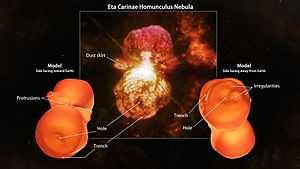Homunculus Nebula
| reflection nebula | |
|---|---|
| Emission nebula | |
 | |
| Observation data: J2000 epoch | |
| Right ascension | 10h 45m 03.6s |
| Declination | −59° 41′ 04″ |
| Distance | 7,500 ly |
| Apparent magnitude (V) | 6.21 (-0.8–7.9) |
| Constellation | Carina |
| Notable features | Bipolar nebula |
The Homunculus Nebula is a bipolar emission and reflection nebula surrounding the massive star system Eta Carinae. The nebula is embedded within the much larger Eta Carinae Nebula, an ionized hydrogen (H II) region. The Homunculus (from the Latin meaning Little Man) is believed to have been ejected in an enormous outburst from Eta Carinae. Light from this event reached Earth in 1841, creating a brightening event in the night sky which was visible from the Earth's surface at the time. During the event (as seen from Earth) Eta Carinae briefly became the second-brightest star in the sky, after Sirius; but the ejected gas and dust have since obscured much of its light. The massive — near supernova — explosion produced two polar lobes, and a large but thin equatorial disk, all moving outward at 670 km/s (1,500,000 mph). Future eruptions remain a distinct possibility.
Though Eta Carinae is some 7,500 light-years away, its luminosity is so great that relatively small structures only 10 billion miles across — about the diameter of our solar system — can be distinguished. Dust lanes, tiny condensations, and strange radial streaks all appear with unprecedented clarity for such distant phenomena. The irregular, blob-like lobes of the outer ejecta are much fainter than the brilliant central star, by about 100,000 times. Excess violet light escapes along the equatorial plane between the bipolar lobes. Apparently there is relatively little dust-debris between the lobes, as most of the blue light is able to escape. On the other hand, the lobes contain large amounts of dust which preferentially absorb blue light, causing the lobes to appear reddish.
Shape
Some astrophysicists hypothesize the unusual shape of the Homunculus nebula can be attributed to a "peanut" shape of the star — or a binary star system (see below). It is believed that interacting blast waves from the brightening event(s) observed in 1841 have created a standing wave at the intersection of the two sides of the wave, gravitationally grouping the ejecta into a plane.[1]
The Homunculus-Eta Carinae system is currently one of the most massive that can be studied in great detail. Until 2005, this system was thought to contain the most massive single star known, but Eta Carinae was recently demoted to a binary system.[2] Twenty-first century observations have indicated that the most massive star in the Eta Carinae multiple-star system probably has more than 100 times the mass of the Sun.[3] Other known massive stars are significantly more luminous and more massive than Eta Carinae.
Three-dimensional model

On July 8, 2014 NASA astronomers created a 3D model of the Humuculus Nebula using data collected at the European Southern Observatory's Very Large Telescope. The study also discovered arm-like structures off of each lobe.[4]
References
- ↑ Astronomy Magazine, June, 2007 Cover story "The Supernova Next Door by Francis Reddy
- ↑ ^ a b c Nancy Neal-Jones, Bill Steigerwald, "NASA Satellite Detects Massive Star Partner", NASA Goddard Space Flight Center, 1 November 2005
- ↑ Frommert, Hartmut & Kronberg, Christine (February 2, 1998). "Peculiar star Eta Carinae, in Carina". Students for the Exploration and Development of Space (SEDS). Retrieved 2012-02-20.
- ↑ Francis Reddy (July 8, 2014). "Astronomers Bring The Third Dimension To A Doomed Star's Outburst,". NASA's Goddard Space Flight Center. Retrieved 2015-02-25.
External links
- 3D Homunculus Nebula (Astronomy Picture of the Day 2014 July 17)